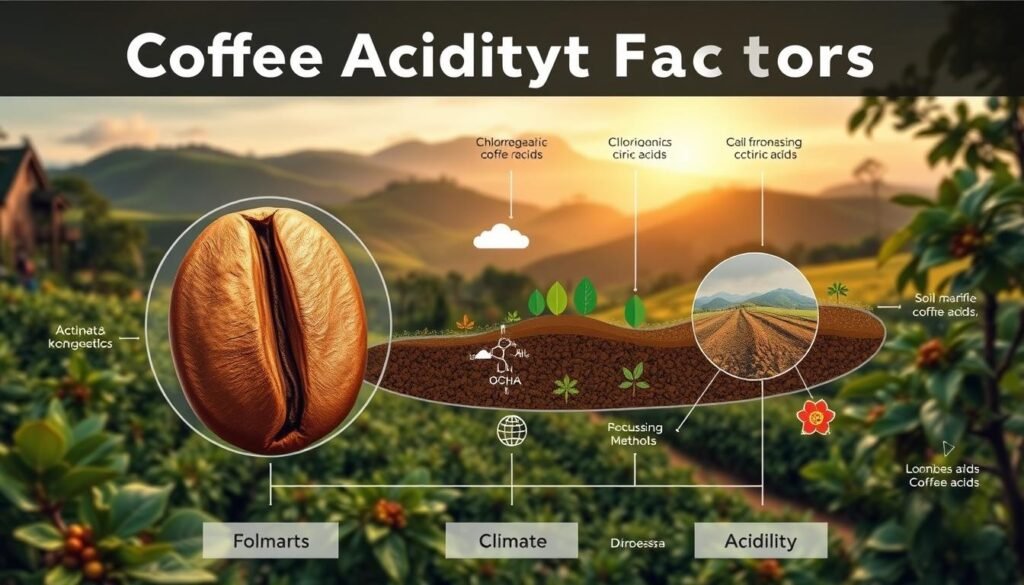Did you know that over 60% of specialty coffee lovers rank acidity as the defining trait of a memorable cup? This vibrant characteristic isn’t about harshness or bitterness—it’s the bright, crisp sensation that makes your morning brew sparkle like citrus or dance like a dry wine.
When I talk about acidity here, I’m describing flavor—not pH levels. Think of it as the lively zing that balances sweetness and depth in your mug. Light roasts often highlight fruity or floral notes, while darker roasts let deeper chocolatey tones shine. A well-crafted cup harmonizes these elements, creating layers that keep you coming back for another sip.
Beans play a starring role too. Growing conditions, processing methods, and roast profiles all shape how acidity emerges. For instance, Ethiopian beans might burst with berry-like tartness, whereas Colombian varieties lean toward nutty sweetness. Mastering this concept unlocks a richer appreciation for every brew, whether you’re sipping a bright pour-over or a velvety espresso.
Key Takeaways
- Acidity refers to the bright, crisp flavors in coffee, not its pH level.
- Balanced cups blend tartness with sweetness for complex flavor profiles.
- Light roasts emphasize fruity notes, while dark roasts highlight deeper tones.
- Bean origin and processing methods directly influence acidic characteristics.
- Recognizing acidity helps you choose brews aligned with your taste preferences.
The Basics of Coffee Acidity
Imagine biting into a perfectly ripe tangerine—that zesty pop on your tongue mirrors how acidity lifts a cup from flat to fascinating. This isn’t science-class pH talk. It’s about the bright, lively energy that makes each sip feel alive.
Defining Acidity in Coffee
I describe acidity as the spark that highlights fruity or floral notes. It’s the crispness you’d find in green apples or lemon zest, not sourness. When balanced, it adds depth without overpowering sweetness or earthy undertones.

Acidity’s Role in Enhancing Flavor
Roasting plays a key role here. Light roasts preserve citrusy brightness, while darker ones mellow it into caramel-like tones. Brewing methods matter too—pour-overs emphasize tanginess, whereas French press highlights body. Even a 30-second shift in extraction time can tilt the balance.
Three elements shape this dynamic:
- Bean origin: High-altitude beans often have sharper acidity.
- Roast profile: Lighter = brighter, darker = smoother.
- Brew technique: Faster methods (espresso) intensify; slower (cold brew) soften.
Mastering these basics helps you choose beans and methods that align with your taste—whether you crave vibrant Kenyan pour-overs or chocolatey Colombian espresso.
Factors That Affect Coffee Acidity
Altitude, roast, and grind aren’t just details—they’re conductors orchestrating your cup’s bright notes. These elements work together to highlight or mute the vibrant characteristics you taste with every sip.

Impact of Bean Origin and Roast Levels
Growing regions leave fingerprints on flavor. High-altitude Arabica beans, like those from Ethiopia’s mountains, develop sharper citrus tones. Cooler climates slow bean maturation, allowing complex acids to form. Lower-elevation regions often yield mellower profiles with nutty undertones.
Roasting transforms these raw potentials. Lighter roasts preserve delicate fruity notes, while darker ones caramelize sugars, softening tartness. I’ve found medium roasts strike a balance—retaining some brightness without overwhelming deeper cocoa flavors.
Brewing Techniques and Grind Size Considerations
Your grind’s texture acts like a control knob for extraction. Finer particles expose more surface area, pulling out acids faster. A pour-over with finely ground beans delivers crisp lemon zest vibes. Coarser grinds in a French press emphasize body over brightness.
Three brewing factors shape acidity:
- Water temperature: Hotter water extracts acids more aggressively
- Contact time: Espresso’s quick 25-second shot vs. cold brew’s 12-hour steep
- Filter type: Paper filters trap oils that carry acidic compounds
Experimenting with these variables lets me dial in exactly how much sparkle I want daily—whether it’s a Tanzanian pour-over that pops or a Sumatran immersion brew that whispers.
What is Acidity in Coffee: A Deep Dive into Flavor and Balance
Your morning brew’s pH level has more in common with orange juice than you might think. While coffee typically ranges from 4.8 to 6.0 on the pH scale, this measurement only tells part of the story. The real magic lies in how specific compounds create vibrant flavors that dance across your palate.
Understanding the pH Scale in Coffee
A lower pH means higher acidity, but here’s the twist: two coffees with identical pH levels can taste wildly different. That’s because chlorogenic acids and other organic compounds shape perception beyond basic measurements. I’ve found Kenyan beans with a pH of 5.1 often taste brighter than Colombian varieties at 5.0 due to their unique acid mix.
| Acid Type | Flavor Contribution | pH Impact |
|---|---|---|
| Chlorogenic | Bright, wine-like | Moderate |
| Citric | Lemon zest pop | High |
| Malic | Green apple crispness | Medium |
| Quinic | Bitter (develops in dark roasts) | Low |
Key Acids and Their Contribution to Taste
Chlorogenic acids dominate unroasted beans, offering antioxidant benefits and a tangy edge that mellows during roasting. Citric acid brings lively citrus notes, while malic adds apple-like freshness. Over-extraction or prolonged brewing can amplify quinic acid, introducing harshness.
These compounds don’t just affect flavor—they team up to create balance. A well-crafted Ethiopian pour-over might showcase citric and phosphoric acids for sparkling complexity, whereas a French press brew emphasizes mellower malic tones. Recognizing these players helps me choose beans and methods that highlight my preferred taste spectrum.
Tasting Experience: How Acidity Shapes Your Cup
Ever noticed how some coffees make your taste buds tingle like effervescent soda? That’s acidity working its magic. My morning ritual often involves comparing cups side by side—one bursting with vibrancy, another offering velvety warmth. These contrasts reveal how acidity defines a brew’s personality.
Interplay Between Brightness and Smoothness
Higher acidity coffees feel like biting into a sun-ripened peach. I recently tried a Kenyan pour-over with razor-sharp citrus notes that danced alongside honey-like sweetness. The brightness cut through richness, creating balance. Low acidity options, like Sumatra Mandheling, wrap the tongue in smooth cocoa tones—comforting but less dynamic.
Identifying Flavor Nuances
Acidity acts as a flavor spotlight. Ethiopian Yirgacheffe often beams with bergamot and blueberry undertones, while Brazilian Santos leans toward nutty caramel. This table shows how acidity levels shape distinct profiles:
| Acidity Level | Common Notes | Mouthfeel |
|---|---|---|
| High | Lemon, red grape, floral | Crisp, lively |
| Medium | Apple, stone fruit | Balanced |
| Low | Chocolate, almond | Creamy, rounded |
Coffees that tend higher in acidity keep me engaged with evolving flavors—each sip reveals new layers. Smoother cups satisfy when I crave consistency. Recognizing these differences helps me match brews to my mood: zesty for creative mornings, mellow for relaxed evenings.
Managing and Modifying Coffee Acidity
Three strategic adjustments can transform harsh tartness into smooth satisfaction: roast selection, bean choice, and brewing innovation. Let’s explore how to craft cups that align with both your taste buds and well-being.
Optimizing Roast Levels and Bean Selection
Dark roast coffee beans became my go-to for reducing sharpness without sacrificing depth. Extended roasting breaks down chlorogenic acids, mellowing flavors into chocolatey richness. I pair this with low-acid varieties like Brazilian Santos or Sumatran beans—their earthy profiles naturally complement the process.
| Roast Level | Acidity Impact | Flavor Profile |
|---|---|---|
| Light | High brightness | Berry, floral |
| Medium | Balanced | Caramel, nutty |
| Dark | Low acidity | Smoky, cocoa |
Beans grown at lower elevations often have softer acidic notes. I prioritize these when crafting espresso blends for friends with sensitive stomachs.
Exploring Cold Brew and Alternative Brewing Methods
Cold brew coffee slashes acidity by up to 70% through its extended steeping time in cool water. My weekend ritual involves 18 hours of immersion for a silky-smooth concentrate. For hot coffee lovers, try slightly lowering water temperature (195°F instead of 205°F) and shortening extraction time by 10 seconds.
Three adjustments that transformed my morning cup:
- Using coarse grinds to slow acid extraction
- Adding a pinch of salt to neutralize harsh compounds
- Choosing paper filters over metal mesh to trap oils
These methods let me enjoy bright Ethiopian beans without discomfort—proof that smart techniques can harmonize flavor and physiology.
Conclusion
Mastering coffee’s bright side transforms every sip from ordinary to extraordinary. Through years of tasting and brewing, I’ve learned that acidity acts as the conductor of flavor—orchestrating citrus zips, floral whispers, and cocoa depths into harmony.
Three elements shape this experience most: bean origin imprints regional signatures, roast levels dial intensity up or down, and brewing methods control how acids express themselves. High-altitude Ethiopian beans deliver raspberry-like tang, while Sumatran dark roasts wrap the palate in velvety warmth.
Adjusting these factors lets you craft cups that thrill without overwhelming. Switching to cold brew cuts sharpness by 70%, perfect for sensitive stomachs. Opting for paper filters over metal mesh removes excess oils carrying acidic compounds.
My journey continues as I explore how chlorogenic acids interact with roast times and water temperatures. Start yours by experimenting—try a bright Kenyan pour-over one morning, a mellow Brazilian espresso the next. Each cup reveals new dimensions when you understand acidity’s role as coffee’s flavor catalyst.


